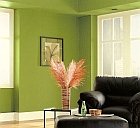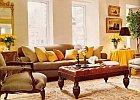Choosing a Paint Color
For an Empty Room
Are you completely redecorating a room and starting from scratch?
Then this tutorial for choosing a paint color will help you turn the "blank canvas" of the walls into a masterpiece, and to create a home that speaks to you and about you.
NOTE: If you already have furniture, art or some decorative items to be used in the room, click here for a guide to choosing interior paint colors from existing decor elements.
Choosing a Paint Color Bare-Handed?
Keep in mind that it's never recommended to start your home color design by selecting paint colors first. Finding furnishings, fabrics and accents that will match your walls is so much harder than finding a paint that will coordinate with your decor. After all, paint can be easily custom matched to anything.
That's why it's a good idea to have some kind of a starting point - an inspirational piece. Even a small vase or decorative pillow (or, at the very least, flooring/tile/stonework) can give your room a direction and serve as a color scheme starter.
But if, for some reason, you have no "starter" available (e.g. new construction home), and must choose a paint color "bare-handed", the following tips should help.
Before you start choosing paint colors, ask yourself these questions:
How much natural light does the room get?

If the room is located on the northern or eastern side of the house, any paint color you choose will appear deeper and duller when applied to the walls.
To combat the darkness and gloominess of such rooms, choose paint colors that are warm and vivid - mid-tones of reds, oranges and yellows are perfect for this.

Rooms that get a lot of sunlight will make any color seem brighter and more intense. To cool down south or west-facing rooms which tend to get hot, decorate them with cool paint colors like greens, blues and violets.
Feel free to paint such rooms with darker, deeper shades - with all the sunlight they will still look inviting.
Notice that artificial lighting can also greatly affect interior wall paint colors. For example, cool fluorescent light intensifies cool colors and weakens warm ones: blue seems more blue, but yellow appears duller. Warm incandescent light enhances warm colors while weakening cool ones. Take this into account when picking paint colors for any room.
Finally, too much light can make any color look washed out. The best way to find out how a particular paint color will behave in your room? Create a large paint color swatch and view the color in different light.
How are you planning to use the room?
The process of choosing a paint color also has its practical side. For instance, you don't want to strain your eyes because you made the mistake of choosing a paint color that is too dark for your office or reading room. Or have to repaint the walls every year because you picked too light of a shade or a wrong paint finish for such a high traffic area as a hallway or kitchen.
Choosing a Paint Color
- The "Safe" Route -

People who have no experience in coordinating interior paint colors, or who just have no idea what color decorations and furniture they will buy for the room, think they can't go wrong with neutrals.
There is a popular myth that neutral interior wall colors like beige, tan or cream are very safe and forgiving. Most people think that neutrals do not interfere with other colors in a negative way. They do. The truth is, neutrals are the most difficult colors to work with, and you will still have to coordinate your decor with them later.
With all that said, it's easy to see why so many people like neutral shades:
Although they do not have character per se, neutrals offer a perfect background for other colors to unfold and give you complete freedom as to what you can do with the room after it is painted.

A room painted with a neutral color can be as calm and restrained, or as fun and bold as you desire. The final result will be determined by the colors you will add to the room with furniture, paintings and accent pieces.
And the best part is, you can change the effect and completely transform the room just by increasing or reducing the number of your colorful accents, or by selecting different interior color schemes in your decorations.
Choosing a Paint Color
- The Fun Route -
If you are good at picking paint colors, or if you simply have the guts to try something new, this is your chance to make a personal statement. Whatever you want to say, or whatever you want your home to say about you, you can express it with color.
Just be wary of popular color fads, because those colors tend to quickly become common, tired and old. Instead, choose interior paint colors that spontaneously attract you and make you feel comfortable naturally. Remember that you will have to live with large amounts of the color you pick for at least a few years.
Select your favorite color family, then look at the variations that exist within that color - warm and cool, dull and intense, light and dark (you can get color chips or a fan deck from any paint store). Pick 2 or 3 shades that you like best and test them using large paint color swatches. Check them out at different times of the day and decide which one is the winner.
After choosing a paint color and painting the walls, you will have 2 options for decorating the room:

1. Play it safe.
Again, neutrals come to the rescue! If the wall color provides all the drama you need, decorate the room with furniture and accents in neutral tones.
2. Play it up.

To really maximize the effect of the wall color, use a color wheel to come up with a complete color scheme for the room. Then use the colors from the scheme in your furnishings and decorations. Again, your color scheme can be as vivid or as subdued as you wish.









Leave a Comment: